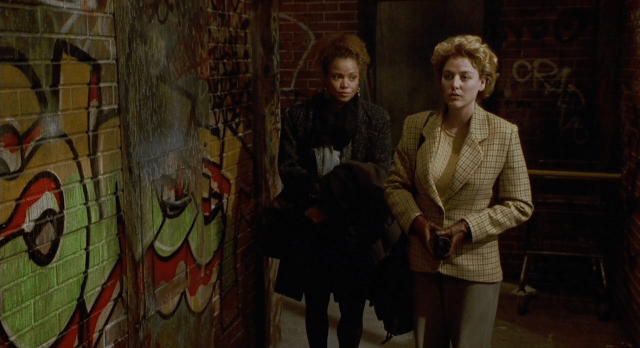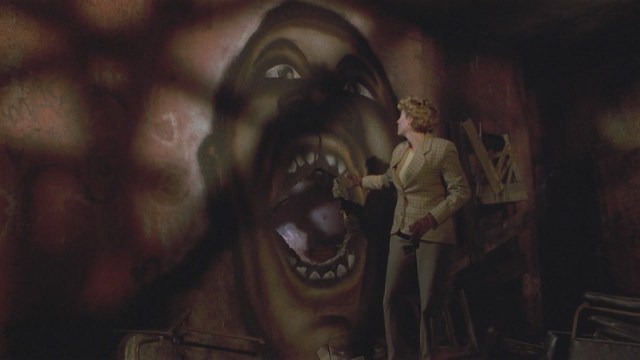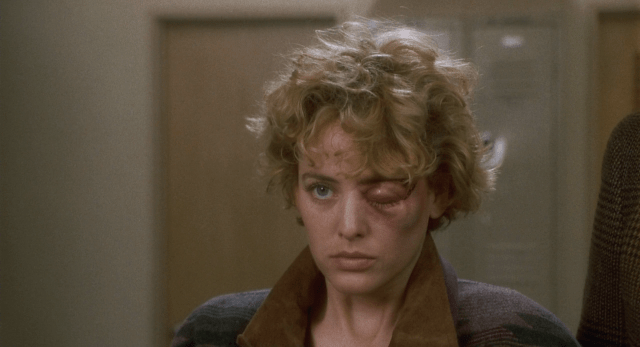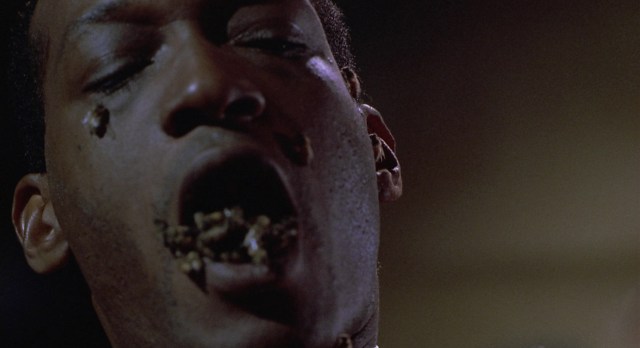Candyman. 1992. Directed & Written by Bernard Rose; based on the story “The Forbidden” by Clive Barker.
Starring Virginia Madsen, Tony Todd, Xander Berkeley, Kasi Lemmons, Vanessa Williams, DeJuan Guy, Marianna Elliott, Ted Raimi, Ria Pavia, Mark Daniels, Lisa Ann Poggi, Adam Philipson, Eric Edwards, Carolyn Lowery, & Barbara Alston. PolyGram Filmed Entertainment/Propaganda Films.
Rated R. 99 minutes.
Drama/Fantasy/Horror
★★★★1/2
 The idea of a hook hand often has its roots for people in the area of urban legends. So already the infamous, titular Candyman plays on fears. Add to that an excellent basis in the short story “The Forbidden” from Cliver Barker’s Books of Blood. As well as the fact Bernard Rose – proven by his 1988 feature Paperhouse – has a proven ability to give people the creeps.
The idea of a hook hand often has its roots for people in the area of urban legends. So already the infamous, titular Candyman plays on fears. Add to that an excellent basis in the short story “The Forbidden” from Cliver Barker’s Books of Blood. As well as the fact Bernard Rose – proven by his 1988 feature Paperhouse – has a proven ability to give people the creeps.
This 1992 horror film is an amalgamation of different ideas. You can see it as a straight-up slasher horror. Then again, can you? It’s part slasher, part ghost story sub-genre. So there’s a definite crossover of genres here. Some of my favourite movies weave from one genre to the next. Rose expertly crafts a spooky urban legend into a living, breathing work of horror that reaches out of its roots in the past and grabs hold of us. On top of it all, Candyman can be taken as an allegory for urban horror and the white guilt people feel standing on the outside looking in, encountering worse horrors after invading places where they just don’t belong. Or maybe it’s anti-colonialist, set in the sprawl of the urban jungle of the Cabrini-Green housing development of Chicago’s North Side. Either way, Rose takes us to the heart of darkness. He touches on everything from the ghosts of slavery to very real, visceral horror. This is one of my favourites out of the 1990s in terms of horror. I still remember first seeing it, and now when I watch it still scares me. A great ride through fantasy-horror territory, along with a solid dose of human drama to give the terror some actual weight.

Helen Lyle (Virginia Madsen) and her friend Bernie Walsh (Kasi Lemmons) are students that decide on writing their thesis concerning local urban legends and myths. At the Cabrini-Green housing complex, they investigate the legend of the supposed Candyman (Tony Todd). He is a one-armed man that appears from nowhere if you repeat his name five times at the mirror. What Helen and Bernie decide, not believing in such legends, is to do their thesis on how those legends are actually based around real events, which create these sorts of entities that then dominate a culture.
Only, this legend? May just be true after all. And when Helen finds herself framed for a murder committed by that very same Candyman which she could not bring herself to believe in, the horror of its reality becomes brutally clear to her.

One thing I love about this one is that, at the beginning of the 90s, this movie came out with some real mature horror. The rest of the decade included Scream (though I love it) and other stuff like Urban Legends, I Know What You Did Last Summer, and other similar slashers, which are all filled with pretty young teens. And I’m not saying Virginia Madsen isn’t a beauty. But the fact this story is all centered around adults is something special. Sure, it isn’t innovative for that, it’s not like there aren’t tons of other movies out there in the horror genre involving adults. There’s simply a perfectly timed aspect to Candyman, jammed between the late 90s and those aforementioned titles, and those which came before it in the 80s where slasher movies were often populated with teens being sexualized and promptly murdered after their various debauchery. This is one horror villain whose range exceeds the typical slasher. Not only is he a ghost, an entity of the wretched past, he doesn’t need a stable of teenagers for victims. So it isn’t some schoolyard ghost story, or an urban legend told in the dark around campfires or in the bedrooms of teenage boys and girls during sleepovers. The legend of Candyman moves beyond the realm of childish scares and enters the adult world of nightmares.

While Clive Barker’s original story “The Forbidden” is based in England, the adapted screenplay from Rose moves things to America, specifically to Chicago and the Cabrini-Green housing development. I dig the story, Barker has a knack for all things macabre. However, I also dig the way Rose has transposed the story into an American setting. Because so much of this screenplay deals with the white guilt of Americans over their racist past. In a sense, Madsen’s character Helen embodies the ultimate experience of white guilt. She wants to investigate the supposed Candyman murders, she goes to Cabrini-Green, a place completely out of her element, and she superimposes her perspective over that of the black residents. She wants to shape their story for them, just like all those other white folk that come in wanting a story, wanting something. So through a metaphysical ghost story Helen becomes a real part of the legend, framed for murders committed by this entity, Candyman. Her white guilt has taken her from an outsider’s perspective, to one of a woman whose guilt is palpable and all too real. So now she no longer tells the story, she lives the story. She is the story.

Most of all, Helen’s experience with the Candyman is symbolic of America’s constant, consistent struggle with its racial history. All the horrors of slavery, everything that came out of that period. The story of Candyman’s becoming and the men who terrorized him is a vicious tale, befitting of the post-Civil War era where those memories of slavery still linger, haunting the people, descendants of those who endured amazingly savage experiences fueled by the irrational hate of racism. And it can never be escaped. In the end when Helen tries to do the right thing, or at least the best thing she could at that point, she must purge herself in the fire outside Cabrini-Green. Because it is not her place from the start to interject herself into the black struggle. So she becomes the opposite of what she’d hoped, a woman who kills black people, steals a black baby, all setup by the Candyman. Her white guilt and need to be the white saviour is shockingly derailed, which allows Rose to also give us some wonderful, vividly nasty horror, too.

The gorgeous, dreadful vision of Bernard Rose and Clive Barker collide in 1992’s Candyman, still one of the movies that scares me most. There will always be unsettling aspects to Tony Todd’s villainous persona. But everything down to the writing and execution of the effects, all of it, works as a complete package. Horror and sociology come together to make this ghostly slasher something bigger than the sum of its parts. It isn’t a by-the-numbers sub-genre horror that simply goes through the motions. At times Candyman plays perectly into those expectations, others it subverts the norm we’d usually expect. Regardless, it is a terrifying modern horror that plays on white guilt and repressed racial history. It haunts my nightmares to this day. You can’t ask any more of a scary movie.

